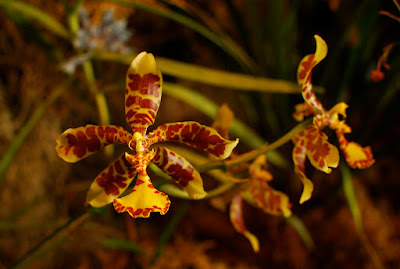Rossioglossum insleayi is native to Mexico. This orchid is found in mountain forests in the states of Guerrero, Jalisco, México, Michoacán and Oaxaca. It grows at an altitude of 1500-2500 m...
Rossioglossum insleayi also called as Insleay's Rossioglossum, Odontoglossum insleayi, Odontoglossum insleayi var. irmschootianum, Odontoglossum insleayi var. leopardinum, Odontoglossum insleayi var. pantherinum, Oncidium insleayi, Odontoglossum lawrenceanum, Rossioglossum splendens var. imschootianum, Rossioglossum hagsaterianum f. aureum, Rossioglossum splendens var. leopardinum, Rossioglossum splendens var. pantherinum, is a species of the genus Rossioglossum. This species was described by Leslie Andrew Garay & George Clayton Kennedy in 1976.
IDENTIFY ROSSIOGLOSSUM INSLEYAI
Rossioglossum insleayi is native to Mexico. This orchid is found in mountain forests in the states of Guerrero, Jalisco, México, Michoacán and Oaxaca. It grows at an altitude of 1500-2500 m. These plants usually occur in oak or pine-oak forests on the slopes directed towards the Pacific Ocean, quite close to the ocean, but sometimes they are found inland.
It is a medium sized, cool to cold growing epiphyte, which reaching a height of 30 cm with ovoid, laterally compressed, ancipitous, longitudinally furrowed with age, grey green, up to 8 cm long and 6 cm wide pseudobulbs partially enveloped basally by several , distichous, imbricating, triangular, acute, evanescent sheaths and carrying 2 to 3 apical, oblong-elliptic, arching to spreading, glaucous, grey green, acute and narrowed below into the conduplicate petiole-like base, up to 22 cm long and 7 cm wide leaves.
Insleay's Rossioglossum flowers on an erect, axillary, 30 to 40 cm long, 5 to 10 flowered inflorescence arising on a newly matured pseudobulb through the basal sheaths with faintly fragrant flowers held in the upper third and occurring in the fall and winter. The flowers are up to 8 cm across horizontally laid inner petals. Pale to gold petals of both whorls have a large number of irregular spots arranged transversely, with stripes or lines in reddish-brown or nut-brown. The brightly yellow lip has a series of spots or stripes with irregular shapes, velvety, with a crimson color, brownish-red spots and stripes around its edges and across the claw at the base. The spine is yellow.
ROSSIOGLOSSUM INSLEYAI CARE AND CULTURE
Cultural information should only be used as a guide, and should be to be adapted to suit you. Your physical location; where you grow your plants, how much time you have to devote to their care, and many other factors, will need to be taken into account. Only then can you decide on the cultural methods that best suit you and your plants.
Light:
Rossioglossum insleayi needs a light level of 10000-15000 lux.
Temperature:
In summer, the average day temperature is 23-26 ° C, night 13 ° C, and daily amplitude 10-13 ° C. In the spring, at the end of the dry season, the average day temperature is 24-28 ° C, the night 7-12 ° C, and the daily difference is 16-18 ° C.
Humidity:
Insleay's Rossioglossum needs the humidity of 75-80% for about 3 months at the end of summer and at the beginning of autumn, in the middle of autumn falls to almost 60%, after which in the spring it drops to 40-45%.
Substrate, growing media and repotting:
The majority of those cultivating Rossioglossum insleayi recommend as a medium a bark of small or medium granulation with the addition of humectants and cultivation in plastic pots. Repotting can be done when the growth of new roots is observed.
Watering:
Precipitation is abundant in summer and early autumn. In autumn, their number rapidly decreases and a dry season lasts until the following spring. The cultivated plants should be abundantly watered during active growth, but excellent drainage should be ensured.
Fertilizer:
During the active growth, the plants should be fertilized every week 1/4-1/2 of the recommended dose of fertilizer for orchids.
Rest period:
In winter, Rossioglossum insleayi should be significantly reduced in water, providing only enough to protect pseudobulbs from excessive wrinkling. Usually an occasional morning fogging between rare, light watering is sufficient. Fertilization should be eliminated until new growths appear in the spring and more watering is required.















COMMENTS